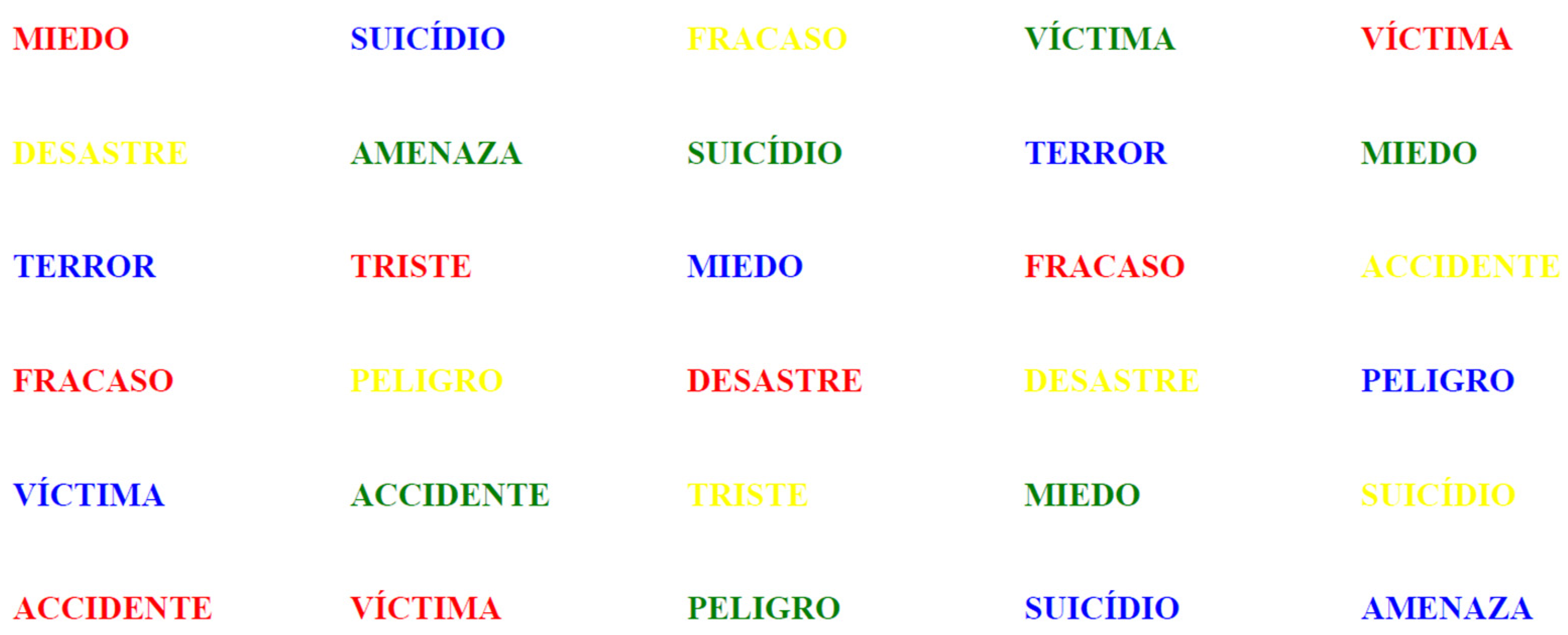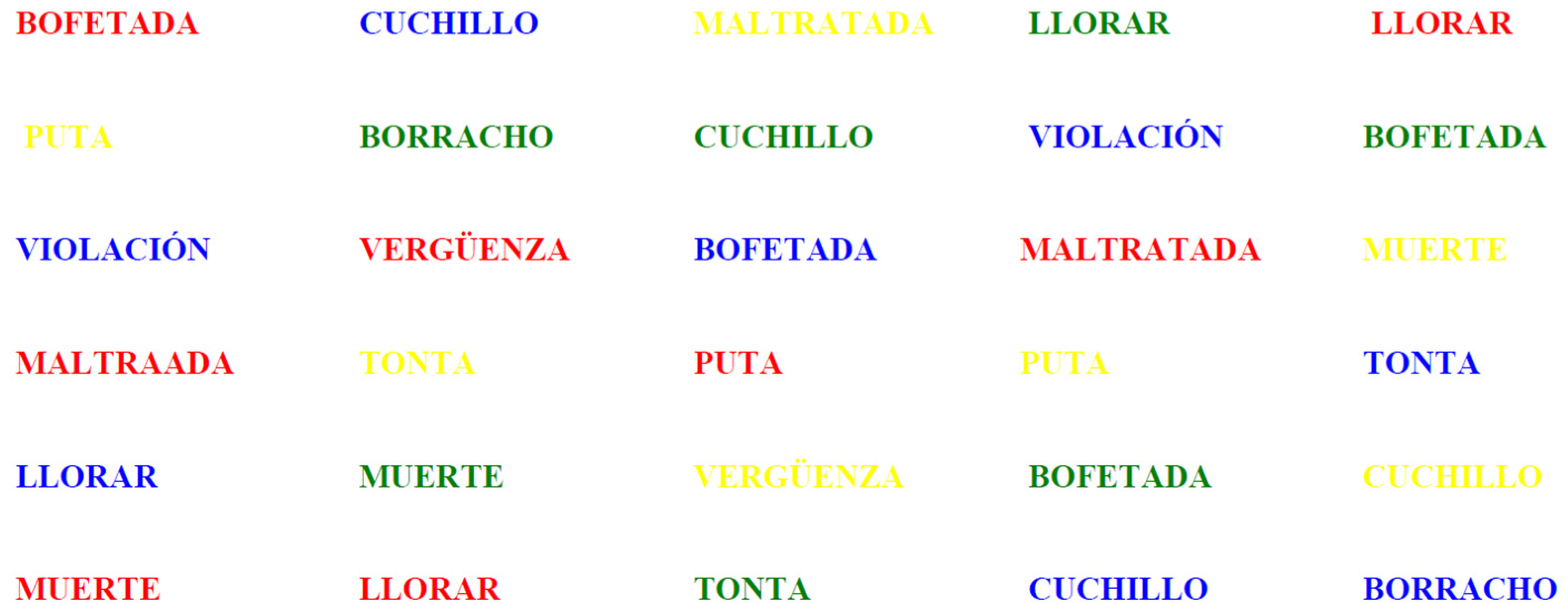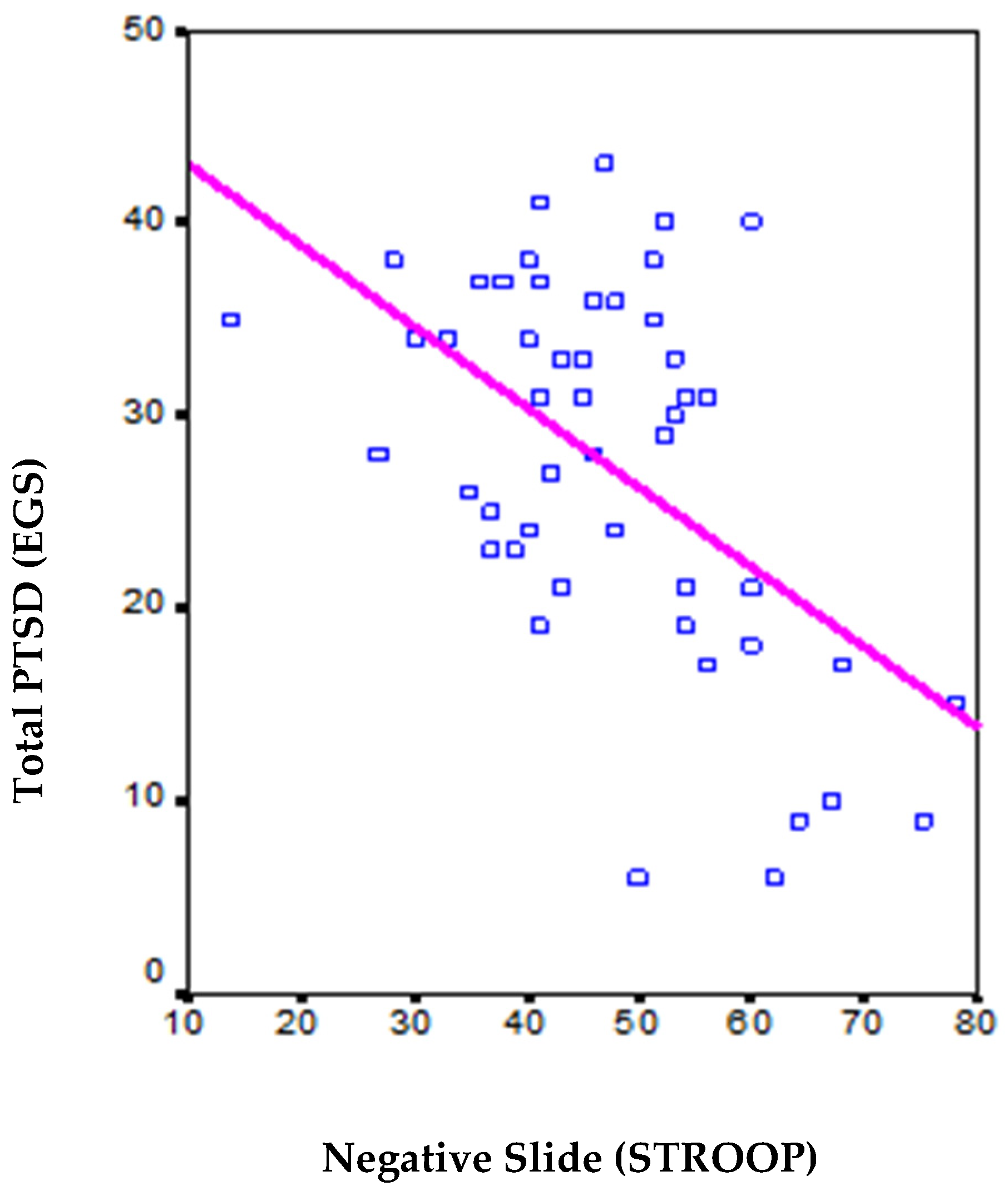Adaptation of an Emotional Stroop Test for Screening of PTSD Related to Intimate Partner Violence in Spanish-Speaking Women
Abstract
1. Introduction
2. Materials and Methods
2.1. Phase 1—Selection of Words for the Neutral and Positive (or Emotional) Word Sheets
2.2. Phase 2—Selection and Validation of Words for the Negative (or Activating) Word Sheet
2.2.1. First Stage—Literature Review
2.2.2. Second Stage—First Selection of Negative (or Activating) Words
2.2.3. Third Stage—Second Selection of Negative (or Activating) Words
2.2.4. Fourth Stage—Final Selection of Negative (or Activating) Words
2.3. Phase 3—Development of the Emotional Stroop Test for Detecting PTSD in Women Affected by Domestic Violence
2.4. Phase 4—The Final Study: The Emotional Stroop Test for Detecting PTSD in Women Victims of Domestic Violence and the Post-Traumatic Stress Disorder Symptom Severity Scale
2.5. Phase 5—Data Analysis
3. Results
4. Discussion
5. Patents
Author Contributions
Funding
Institutional Review Board Statement
Informed Consent Statement
Data Availability Statement
Acknowledgments
Conflicts of Interest
References
- American Psychiatric Association. (2014). DSM-5: Manual diagnóstico y estadístico de los trastornos mentales. Centro de Investigación Biomédica en Red de Salud Mental (CIBERSAM) Editorial Médica Panamericana. [Google Scholar]
- Cabaco, A. S., & Armas, M. (2000). Atención selectiva y procesamiento de la información en los trastornos de la alimentación. Revista Iberoamericana de Educación y Salud en el Trabajo, 1, 165–183. [Google Scholar]
- Cabaco, A. S., Capataz, I., Bonantini, C., & Hage, S. (2002). Hipervigilancia emocional y vulnerabilidad a trastornos alimenticios (Estudio transcultural España, Brasil y Argentina). Revista Iberoamericana de Educación y Salud en el Trabajo, 2–3, 211–228. [Google Scholar]
- Cohen, J. (1988). Statistical power analysis for the behavioral sciences (2nd ed.). Routledge. [Google Scholar] [CrossRef]
- Costello, K., & Greenwald, B. D. (2022). Update on domestic violence and traumatic brain injury: A narrative review. Brain Sciences, 12(1), 122. [Google Scholar] [CrossRef]
- Dell’Oste, V., Fantasia, S., Gravina, D., Palego, L., Betti, L., Dell’Osso, L., Giannaccini, G., & Carmassi, C. (2023). Metabolic and inflammatory response in post-traumatic stress disorder (PTSD): A systematic review on peripheral neuroimmune biomarkers. International Journal of Environmental Research and Public Health, 20(4), 2937. [Google Scholar] [CrossRef] [PubMed]
- Dokkedahl, S. B., Kirubakaran, R., Bech-Hansen, D., Kristensen, T. R., & Elklit, A. (2022). The psychological subtype of intimate partner violence and its effect on mental health: A systematic review with meta-analyses. Systematic Reviews, 11(1), 1–16. [Google Scholar] [CrossRef] [PubMed]
- Echeburúa, E., Amor, P. J., Muñoz, J. M., Sarasua, B., & Zubizarreta, I. (2017). Escala de gravedad de síntomas del trastorno de estrés postraumático según el DSM-5: Versión forense (EGS-F). Anuario de Psicología Jurídica, 27(1), 67–77. [Google Scholar] [CrossRef]
- Echeburúa, E., Amor, P. J., Sarasua, B., Zubizarreta, I., Holgado-Tello, F. P., & Muñoz, J. M. (2016). Escala de gravedad de síntomas revisada (EGS-R) del trastorno de estrés postraumático según el DSM-5: Propiedades psicométricas. Terapia Psicológica, 34(2), 111–128. [Google Scholar] [CrossRef]
- Echeburúa, E., Corral, P., Zubizarreta, B., & Sarasua, B. (1995). Trastorno de estrés postraumático crónico en víctimas de agresiones sexuales. Fundación Paideia. [Google Scholar]
- Fang, J., & Donley, E. (2022). Intimate partner violence screening tools in emergency departments: A scoping review. Practice, 34(2), 149–165. [Google Scholar] [CrossRef]
- García, M. P., Fasfous, A., & Ruiz, Á. L. (2023). Cómo hacer la evaluación neuropsicológica de mujeres víctimas: El Proyecto Believe. In Neuropsicología de la violencia de género (pp. 93–130). Editorial Universidad de Granada. Available online: https://www.researchgate.net/publication/374228949_Neuropsicologia_de_la_violencia_de_genero (accessed on 1 March 2025).
- Golden, C. J. (1994). Stroop. Test de colores y palabras. Tea Ediciones. [Google Scholar]
- Jia, Y. L., Yang, B. N., Yang, Y. H., Zheng, W. M., Wang, L., Huang, C. Y., Lu, J., & Chen, N. (2024). Application of machine learning techniques in the diagnostic approach of PTSD using MRI neuroimaging data: A systematic review. Heliyon, 10, e28559. [Google Scholar] [CrossRef]
- Joyal, M., Wensing, T., Levasseur-Moreau, J., Leblond, J., Sack, A. T., & Fecteau, S. (2019). Characterizing emotional Stroop interference in posttraumatic stress disorder, major depression and anxiety disorders: A systematic review and meta-analysis. PLoS ONE, 14(4), e0214998. [Google Scholar] [CrossRef]
- Labrador, F. J., Rincón, P. P., De Luis, P., & Fernández-Velasco, R. (2004). Mujeres víctimas de la violencia doméstica. Programa de actuación. Ediciones Pirámide. [Google Scholar]
- Maercker, A. (2021). Development of the new CPTSD diagnosis for ICD-11. Borderline Personality Disorder and Emotional Dysregulation, 8, 1–4. [Google Scholar] [CrossRef]
- Marín Torices, M. I., Hidalgo-Ruzzante, N., Daugherty, J. C., Jiménez-González, P., & Perez Garcia, M. (2018). Validation of neuropsychological consequences in victims of intimate partner violence in a Spanish population using specific effort tests. The Journal of Forensic Psychiatry & Psychology, 29(1), 86–98. [Google Scholar] [CrossRef]
- Neria, Y. (2021). Functional neuroimaging in PTSD: From discovery of underlying mechanisms to addressing diagnostic heterogeneity. American Journal of Psychiatry, 178(2), 128–135. [Google Scholar] [CrossRef]
- Olábarri Azagra, J. (2022). El idioma español: Situación actual y mirada al futuro. Un cambio de modelo. CEU Ediciones. Available online: https://www.ceuediciones.es/catalogo/libros/educacion/el-idioma-espanol-situacion-actual-y-mirada-al-futuro-un-cambio-de-modelo/ (accessed on 1 March 2025).
- Pill, N., Day, A., & Mildred, H. (2017). Trauma responses to intimate partner violence: A review of current knowledge. Aggression and Violent Behavior, 34, 178–184. [Google Scholar] [CrossRef]
- Sippel, L. M., & Marshall, A. D. (2011). Posttraumatic stress disorder symptoms, intimate partner violence perpetration, and the mediating role of shame processing bias. Journal of Anxiety Disorders, 25(7), 903–910. [Google Scholar] [CrossRef] [PubMed]
- Spencer, C. M., Keilholtz, B. M., Palmer, M., & Vail, S. L. (2022). Mental and physical health correlates for emotional intimate partner violence perpetration and victimization: A meta-analysis. Trauma, Violence, & Abuse, 25(1), 41–53. [Google Scholar] [CrossRef]
- Straub, E. R., Schmidts, C., Kunde, W., Zhang, J., Kiesel, A., & Dignath, D. (2022). Limitations of cognitive control on emotional distraction–congruency in the color stroop task does not modulate the emotional stroop effect. Cognitive, Affective, & Behavioral Neuroscience, 22, 21–41. [Google Scholar] [CrossRef]
- Stroop, J. R. (1935). Studies of interference in serial verbal reactions. Journal of Experimental Psychology, 18(6), 643–662. [Google Scholar] [CrossRef]
- Swick, D., Lwi, S. J., Larsen, J., & Ashley, V. (2024). Executive functioning in posttraumatic stress disorder: Understanding how inhibition, switching, and test modality affect reaction times. Neuropsychology, 38(6), 516–530. [Google Scholar] [CrossRef]
- Tolchin, G., Aafjes-van Doorn, K., Horne, S., Baitch, R., & Silberschatz, G. (2023). Measures of trauma exposure and trauma response: A scoping review. Journal of Clinical Psychology, 79, 2668–2684. [Google Scholar] [CrossRef]
- Williams, J. M. G., Mathews, A., & MacLeod, C. (1996). The emotional Stroop task and psychopathology. Psychological Bulletin, 120(1), 3–24. [Google Scholar] [CrossRef] [PubMed]
- World Health Organization. (2021). Violence against women prevalence estimates, 2018: Global, regional and national prevalence estimates for intimate partner violence against women and global and regional prevalence estimates for non-partner sexual violence against women. Executive summary. World Health Organization. Available online: https://apps.who.int/iris/handle/10665/341338 (accessed on 1 March 2025).
- Yetter, M., Philippi, C. L., & Bruce, S. E. (2023). Altered functional connectivity between cortical networks associated with inhibitory control in trauma-exposed females. Psychiatry Research: Neuroimaging, 333, 111671. [Google Scholar] [CrossRef] [PubMed]




| Negative Words from Literature Review | Negative Words from Field Work | |||
|---|---|---|---|---|
| Rape | Raped | Force | Imbecile | Death |
| Assault | Incest | Cry | Torture | Drunk |
| Harasser | Vexed | Harassing | Indefence | Disgraced |
| Screaming | Abused | Male | Pounding | Bitch |
| Forcejacking | Penis | Flash | Humiliation | Fool |
| Trapped | Victim | Pain | Night | Door |
| Penetration | Shame | Engage | Useless | Jealous |
| Nightmare | Bullier | Disturb | Isolated | Denigrate |
| Attack | Blowjob | Exploit | Children | Shame |
| Runaway | Erection | Damage | Threat | Whore |
| Fear | ||||
| Negative Words Proposed by the Judges Sorted by Decreasing Score | |||||
|---|---|---|---|---|---|
| Guilt | Alone | Police | Bruises | Slave | Stupid |
| Crazy | Thump | Freedom | Pinches | Serve | Silly |
| Knife | Fuck | Illness | Bullshit | Drugs | Frustration |
| Solitude | Bang | Friend | Punching | Maid | Parents |
| Isolated | Slap | Hiding | Fighting | Lawyer | Shame |
| Kicks | Shotgun | Silence | Threats | Queens | Kill |
| Warrior | Tread | Dumb | Man | Sucking | Punish |
| Dick | Penalty | Punch | Screams | Shit | Report |
| Beast | Coup | Surprise | Vengeance | Servant | Marks |
| Semantic Fields | Negative Words Selected According to Formal Criteria | |||||
|---|---|---|---|---|---|---|
| Physical violence | Thump | Slap | Bang | Kicks | Pounding | Death |
| Verbal violence | Fool | Bitch | Crazy | |||
| Sexuality | Fuck | Dick | Rape | |||
| Self-esteem | Abused | Shame | Alone | |||
| Setting of domestic violence | Children | Cry | Drunk | Knife | Fear | Jealous |
| Neutral Blade | Positive Blade (or Emotional) | Negative Blade (or Activating) |
|---|---|---|
| House | Fear | Slap |
| Stone | Suicide | Knife |
| Lift | Failure | Abused |
| Garden | Victim | Cry |
| Sofa | Disaster | Bitch |
| Curtain | Threat | Drunk |
| Cat | Terror | Rape |
| Heat | Fear | Shame |
| Flag | Accident | Death |
| Mat | Danger | Fool |
| Variable | Group | n | M (SD) | t (df) | p | Cohen’s d |
|---|---|---|---|---|---|---|
| Total PTSD (EGS) | Non-Victims of IPV Women | 50 | 6.78 (12.82) | 9.08 (98) | 0.000 * | 1.815 |
| Women Victims of IPV | 50 | 27.44 (9.73) | ||||
| Re-living PTSD (EGS) | Non-Victims of IPV Women | 50 | 2.38 (4.70) | 7.00 (98) | 0.000 * | 1.4 |
| Women Victims of IPV | 50 | 8.92 (4.64) | ||||
| Avoidance PTSD (EGS) | Non-Victims of IPV Women | 50 | 2.08 (4.49) | 10.24 (98) | 0.000 * | 2.046 |
| Women Victims of IPV | 50 | 10.58 (3.79) | ||||
| Psychophysiological activation PTSD (EGS) | Non-Victims of IPV Women | 50 | 2.32 (4.67) | 6.42 (98) | 0.000 * | 1.284 |
| Women Victims of IPV | 50 | 7.94 (4.06) |
| Variable | Group | n | M (SD) |
|---|---|---|---|
| Neutral words | Non-Victims of IPV Women | 50 | 58.34 (11.80) |
| Women Victims of IPV | 50 | 52.04 (11.10) | |
| Positive (or emotional) words | Non-Victims of IPV Women | 50 | 57.84 (15.58) |
| Women Victims of IPV | 50 | 50.48 (11.77) | |
| Negative (or activating) words | Non-Victims of IPV Women | 50 | 52.22 (14.97) |
| Women Victims of IPV | 50 | 47.28 (12.29) |
| Group | SS | Dƒ | MS | F | p |
|---|---|---|---|---|---|
| Non-Victims of IPV Women | 31.48 | 1.99 | 15.85 | 0.54 | 0.58 |
| Women Victims of IPV | 588.85 | 1.85 | 317.62 | 8.19 | 0.001 * |
| Error (Non-Victims of IPV Women) | 2846.52 | 97.30 | 29.26 | ||
| Error (Women Victims of IPV) | 3521.81 | 90.85 | 38.77 |
| Group | Stroop (I) | Stroop (J) | Mean Difference (I-J) | Std. Error | Sig.b | 95% CI for Difference Lower Bound | 95% CI for Difference Upper Bound |
|---|---|---|---|---|---|---|---|
| Non-Victims of IPV Women | 1 | 2 | 0.50 | 1.09 | 0.650 | −1.70 | 2.70 |
| 3 | 1.12 | 1.03 | 0.283 | −0.95 | 3.19 | ||
| 2 | 1 | −0.50 | 1.09 | 0.650 | −2.70 | 1.70 | |
| 3 | 0.62 | 1.11 | 0.578 | −1.60 | 2.84 | ||
| 3 | 1 | −1.12 | 1.03 | 0.283 | −3.19 | 0.95 | |
| 2 | −0.62 | 1.11 | 0.578 | −2.84 | 1.60 | ||
| Women Victims of IPV | 1 | 2 | 1.56 | 1.18 | 0.191 * | −0.81 | 3.93 |
| 3 | 4.76 | 1.35 | 0.001 * | 2.06 | 7.46 | ||
| 2 | 1 | −1.56 | 1.18 | 0.191 * | −3.93 | 0.81 | |
| 3 | 3.20 | 1.06 | 0.004 * | 1.08 | 5.32 | ||
| 3 | 1 | −4.76 | 1.35 | 0.001 * | −7.46 | −2.06 | |
| 2 | −3.20 | 1.06 | 0.004 * | −5.32 | −1.08 |
| Comparison | Initial p-Value | Bonferroni p-Value |
|---|---|---|
| 2 vs. 3 (Non-Victims) | 0.283 | 1.0 |
| 3 vs. 1 (Non-Victims | 0.283 | 1.0 |
| 1 vs. 2 (Victims) | 0.191 | 1.0 |
| 2 vs. 3 (Victims) | 0.004 | 0.024 |
| 3 vs. 1 (Victims) | 0.001 | 0.006 |
Disclaimer/Publisher’s Note: The statements, opinions and data contained in all publications are solely those of the individual author(s) and contributor(s) and not of MDPI and/or the editor(s). MDPI and/or the editor(s) disclaim responsibility for any injury to people or property resulting from any ideas, methods, instructions or products referred to in the content. |
© 2025 by the authors. Licensee MDPI, Basel, Switzerland. This article is an open access article distributed under the terms and conditions of the Creative Commons Attribution (CC BY) license (https://creativecommons.org/licenses/by/4.0/).
Share and Cite
Mata-Gil, S.; Fernández-Mateos, L.M.; Sánchez-Cabaco, A.; Del Moral-Martínez, J.; Castillo-Riedel, E. Adaptation of an Emotional Stroop Test for Screening of PTSD Related to Intimate Partner Violence in Spanish-Speaking Women. Behav. Sci. 2025, 15, 343. https://doi.org/10.3390/bs15030343
Mata-Gil S, Fernández-Mateos LM, Sánchez-Cabaco A, Del Moral-Martínez J, Castillo-Riedel E. Adaptation of an Emotional Stroop Test for Screening of PTSD Related to Intimate Partner Violence in Spanish-Speaking Women. Behavioral Sciences. 2025; 15(3):343. https://doi.org/10.3390/bs15030343
Chicago/Turabian StyleMata-Gil, Sarai, Luz M. Fernández-Mateos, Antonio Sánchez-Cabaco, Jerónimo Del Moral-Martínez, and Eduardo Castillo-Riedel. 2025. "Adaptation of an Emotional Stroop Test for Screening of PTSD Related to Intimate Partner Violence in Spanish-Speaking Women" Behavioral Sciences 15, no. 3: 343. https://doi.org/10.3390/bs15030343
APA StyleMata-Gil, S., Fernández-Mateos, L. M., Sánchez-Cabaco, A., Del Moral-Martínez, J., & Castillo-Riedel, E. (2025). Adaptation of an Emotional Stroop Test for Screening of PTSD Related to Intimate Partner Violence in Spanish-Speaking Women. Behavioral Sciences, 15(3), 343. https://doi.org/10.3390/bs15030343






